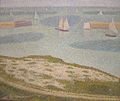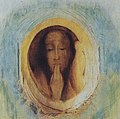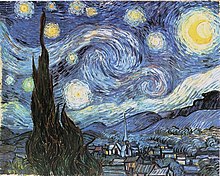Lillie P. Bliss
Lillie P. Bliss (actually Lizzie Plummer Bliss ) (born April 11, 1864 in Boston , † March 12, 1931 in New York City ) was an American art collector and patron . At the beginning of the 20th century she was one of the leading collectors of modern art in New York. She was one of the lenders of the trend-setting Armory Show in 1913 and contributed to the public attention of this art through other exhibitions. In 1929 she played a key role in founding the Museum of Modern Art . After her death, 150 works of art from her collection were donated to the museum. This base of the in-house collection includes works by artists such as Paul Cézanne , Georges Seurat , Paul Gauguin , Henri Matisse , Pablo Picasso and Amedeo Modigliani .
Life
Family and youth
Lizzie Plummer Bliss was born in Boston in 1864 as the daughter of the textile merchant Cornelius Newton Bliss and his wife Elisabeth Mary Bliss, née Plummer (1836–1923). She was called Lillie P. Bliss by family and friends since childhood. Of the three siblings, only their brother, Cornelius Newton Bliss, Jr., born in 1874, reached adulthood. When she was two years old, her family moved to New York City. Lillie P. Bliss did not attend school, but received lessons from private tutors. Her father served as Secretary of the Interior of the United States from 1897 to 1899 under President William McKinley . During this time, his daughter repeatedly accompanied him to official events in Washington, as his wife could not attend them due to illness.
Lillie P. Bliss, who was interested in art, got to know actors like Walter Hampden , Ruth Draper and Ethel Barrymore at receptions in her parents' apartment . In her youth, her main artistic interests were in both classical and contemporary music. At the beginning of the 20th century she began to sponsor young pianists and opera singers. In addition, she supported the string quartet (Kneisel Quartet ) led by Franz Kneisel (1885-1917) and sponsored the Juilliard Foundation , which took care of musical training. Her friends included music critic Richard Aldrich and musician Charles Martin Loeffler .
One of the earliest encounters with modern art was visits to exhibitions at the Union League Club of New York . Her father was a member of this club and was president of it from 1902 to 1906. The club has repeatedly shown works by living artists in public exhibitions. For example, 34 works by Claude Monet were on display here in 1891 . After her father's death in 1911, Bliss, who had never married, lived with her mother in an apartment on 37th Street in Manhattan .
Building the art collection
Her earliest artwork purchases included a painting by American painter Arthur B. Davies . She met the artist in his studio and attended art exhibitions with him and the art teacher Mary Quinn Sullivan . In the years that followed, Bliss built up the largest private collection of Davies' works in the United States.
Her friend, the doctor Christian Archibald Herter , occasionally accompanied her piano playing as a leisure cellist. Through him she met his sister-in-law, the painter Adele Herter , who, together with Abby Aldrich Rockefeller and five other women, founded the Women's Cosmopolitan Club in New York City in March 1911 . Lillie P. Bliss joined this association a few months later. They had a lifelong friendship with Abby Aldrich Rockefeller and their common interests later led to the founding of the Museum of Modern Art. In the same year, the Association of American Painters and Sculptors was co-founded by Arthur B. Davies, the artist Walt Kuhn and the Critic Walter Pach counted. Bliss has acquired numerous paintings by Kuhn over the years, and all three played an essential role in the preparation of the Armory Show in 1913, the aim of which was to bring the most modern currents of art to the American public. Other exhibition venues, such as the conservative National Academy of Design , refused to embrace current artistic trends at the time.
Six weeks before the Armory Show began, Bliss acquired two landscapes by Pierre-Auguste Renoir and a painting and a pastel by Edgar Degas in the New York branch of the Durand Ruel gallery . She loaned these pictures to the Armory Show and also helped make the exhibition possible with financial means. She bought numerous works of art from the exhibition, including Silence and Roger and Angelica by Odilon Redon . Long-term friendships developed from personal encounters with the artists represented in the exhibition. This affected painters such as Charles Sheeler , Charles and Maurice Prendergast , whose work she also bought.
The work of Paul Cézanne is a focus of her collection . Bliss bought her first Cézanne ( The Street of 1875) from her friend Arthur B. Davies' collection shortly after the Armory Show closed. Unaffected by negative exhibition reviews, Bliss acquired the painting Fruits and Wine and eight watercolors by the artist in 1916 in the Cézanne exhibition put together by Félix Fénéon in the Montross Gallery in New York .
Pierre-Auguste Renoir:
Brouillard à Guernsey , 1883,
now the Cincinnati Art Museum
Together with her friends, the art collectors Louisine W. Havemeyer and John Quinn , she persuaded the curator for painting, Bryson Burroughs , to organize the Loan exhibition of Impressionist and Post-Impressionist art at the Metropolitan Museum of Art in 1921 . Quinn loaned 26, Bliss twelve (including five Cézannes and her Degas painting) and Havemeyer two works for this exhibition (both women anonymous). The press accused Quinn of being the secret leader of this exhibition, criticized the self-appointed citizens' committee and described the exhibition as "dangerous". The New York World newspaper described the painting Hina Te Fatou ( The Moon and the Earth) by Paul Gauguin from the Quinn Collection as typical of the disgusting Bolshevik works on view in the exhibition. Unimpressed by such criticism, Bliss acquired this painting for her collection a little later.
From 1924 to 1929, Bliss traveled once a year to Europe to find out about the latest artistic developments - especially in France. In contrast, she made purchases for her collection almost without exception through New York art dealers or through the New York branches of European galleries. In addition to current painting, she also acquired individual works of older art during these years. In 1927 she bought a work by the realist Honoré Daumier (The Washerwoman) in addition to a work by the pointellist Georges Seurat (Port-en-Bessin, harbor entrance ) .
The establishment of the Museum of Modern Art
After Arthur B. Davies' death in October 1928, several exhibitions were held in his memory, for which Lillie P. Bliss loaned numerous works of art. At the auction of his art collection, Bliss was one of the buyers, as was Abby Aldrich Rockefeller, and both of them had the idea of founding an institution dedicated to exhibitions of modern art in New York. The steadfast refusal of the Metropolitan Museum of Art to exhibit art from the late 19th century and works by contemporary artists played a decisive role.
In late May 1929, Abby Aldrich Rockefeller invited her friends Lillie P. Bliss and Mary Quinn Sullivan to lunch to discuss the creation of a modern art museum. Another guest at this meeting was the art collector A. Conger Goodyear , who had previously served as a board member of the Albright Art Gallery in Buffalo . Goodyear agreed to serve as president of the circle, Lillie P. Bliss became its assistant, and Abby Aldrich Rockefeller served as treasurer. A short time later, the art historian and collector Paul J. Sachs was joined by an acquaintance of Abby Aldrich Rockefeller, the publisher Frank Crowninshield , a friend of Lillie P. Bliss, and Josephine Porter Boardman , who was friends with Bliss and Rockefeller , who lived in New York ran a literary salon . On November 7th, the Museum of Modern Art's first exhibition opened in rented rooms in the Heckscher Building in Manhattan. For the first exhibition, entitled Cezanne, Gauguin, Seurat, van Gogh , Bliss again contributed several paintings from her collection.
Last years of life and will
Lillie P. Bliss, weakened in the last months of her life by cancer, took an active part in the activities of the Museum of Modern Art until shortly before her death. So she visited the Toulouse-Lautrec / Redon exhibition there on March 2, 1931 , to which she had contributed three works by Redon and her painting by Toulouse-Lautrec. Lillie P. Bliss died on March 12th in New York. She found her final resting place in Woodlawn Cemetery . Two months after her death, the Museum of Modern Art showed in its twelfth exhibition the work of 24 artists from the collection of Lillie P. Bliss in memory of the museum co-founder.
In her will, Lillie P. Bliss gave some charitable institutions, such as the New York Hospital or the New York Association for Improving the Conditions of the Poor , an institution for poor relief, with financial donations. She bequeathed parts of her art collection to the Metropolitan Museum of Art. These included, for example, works by Arthur B. Davies and Claude Monet's painting The Rock Cliffs at Étretat .
To the surprise of her friends at the Museum of Modern Art, she donated the majority of her art collection to this institution with 150 works of art. The museum, initially only intended for exhibition purposes and without its own collection, was thus given the basis of its own collection. The conditions attached to this inheritance in the will conditions included a to be provided on the part of the museum's "firm financial basis" (secure financial basis) within three years. This should serve to permanently secure the collection.
The provision in the will that works of art in the collection may be sold or exchanged for other works of art proved to be forward-looking and helpful for the museum's future holdings. Only three pictures, the two Cézanne paintings Still Life with Apples and Still Life with Ginger Vessel, Sugar Bowl and Oranges, and the picture The Laundress from Daumier, were exempt from this regulation. These works should never be sold but, if unsuitable for the Museum of Modern Art, be given to the Metropolitan Museum. The two pictures by Cézanne are still in the Museum of Modern Art, the painting by Daumier was transferred to the Metropolitan Museum's collection in 1947.
The most important works of the Bliss Collection that have remained in the Museum of Modern Art to this day include, besides Cézanne's still life, his painting Der Badende , as well as the works Portrait Anna Zborowska by Amedeo Modigliani , Still Life in Green by Pablo Picasso , Hina Te Fatou by Paul Gauguin , Port- en-Bessin, harbor entrance by Georges Seurat Interior with violin case by Henri Matisse , as well as Silence and Roger and Angelica by Odilon Redon .
The meaning of this collection was formulated by the first director of the Museum of Modern Art, Alfred H. Barr , with the following sentences: “With the Bliss Collection, New York can now look London, Paris, Berlin, Munich, Moscow and Chicago in the face so far as public collections of modern art are concerned. Without it we would still have had to hang our heads as a backward community. ”(Analogously: With the Bliss Collection, New York can now face London, Paris, Berlin, Munich, Moscow and Chicago as far as public collections of modern art are concerned Without them, we as a backward church would still have to hang our heads. ).
The Lillie P. Bliss Legacy
The "firm financial basis" vaguely described in the will, a kind of foundation capital for the preservation and expansion of the collection, led to lengthy negotiations between the deceased's brother appointed as estate administrator and the board of the Museum of Modern Art. The basis for measuring the amount of this foundation should be the equivalent of the collection donated to the museum. An estimate made by the New York gallery Ferargil put the collection at $ 1,139,036, with Cézanne's three top works The Bathing , Still Life with Apples and Pines and Rocks together with $ 150,000 and Degas Rider in front of a hilly landscape at $ 40,000. Afterwards, Cornelius Newton Bliss and the museum board initially agreed on a sum of 1,000,000 dollars to be raised.
Raising the required amount through donations proved to be extremely difficult in the early 1930s due to the consequences of the global economic crisis . Through negotiations, the Museum of Modern Art was able to negotiate the required amount down to $ 750,000 and then to $ 600,000. Last but not least, this amount was raised through a few large donations. Abby Aldrich Rockefeller contributed $ 200,000 alone, her son Nelson A. Rockefeller and the Carnegie Foundation each provided $ 100,000. In March 1934, the agreed amount was collected and the collection of Lillie P. Bliss legally became part of the museum's holdings. It forms the basis of the museum collection and the proceeds from the amount of money raised have since been available as Lillie P. Bliss Bequest (Lillie P. Bliss Legacy) to expand the collection.
In accordance with the will, the museum gradually sold works of art from the Bliss collection. For example, in the late 1930s, Degas Reiter was sold in front of the hilly landscape for $ 18,000 in order to purchase Picasso's Les Demoiselles d'Avignon with the proceeds and an additional $ 10,000 . In 1941 Vincent van Gogh's Starry Night was acquired through the sale of three further works from the Bliss Collection . The Museum of Modern Art sold three other works from the Bliss Collection to the Metropolitan Museum in 1951. In addition to Odilon Redon's Etruscan vase with flowers and Paul Cézanne's portrait of Antoine Dominique Sauveur Aubert , Pablo Picasso's wife in white was one of these pictures. Other sales included Henri Rousseau's Lion in the Jungle and Camille Pissarros Am Fluss (both now in private collections), as well as Henri de Toulouse-Lautrecs May Belfort (now the Cleveland Museum of Art ) and Pierre-Auguste Renoirs Brouillard à Guernsey (now the Cincinnati Art Museum ).
In return, the Museum of Modern Art acquired paintings by André Derain , Georges Braque , Alexej von Jawlensky , Alberto Giacometti , Balthus , Alexander Archipenko , Juan Gris , Pablo Picasso , Fernand Léger , Theo van Doesburg , Marc with the help of Lillie P. Bliss Bequest Chagall , Piet Mondrian , Lyonel Feininger as well as sculptures by Umberto Boccioni , Henri Matisse , Henry Moore , Constantin Brâncuși , and numerous other works of art.
In addition to the Lillie P. Bliss Bequest, the Lillie P. Bliss International Study Center commemorates the museum co-founder. This study center, located at the Museum of Modern Art, is used for research on art history in the field of modern art.
literature
- Alfred H. Barr, Jr. (Ed.): The Lillie P. Bliss collection . Plantin Press, New York 1934.
- Milton W. Brown: The story of the Armory Show . Abbeville Press, New York 1988, ISBN 0-89659-795-4 :
- Edward T. James, Janet Wilson James, and Paul Boyer (Eds.): Notable American Women, 1607-1950: A Biographical Dictionary . Belknap Press of Harvard University Press, Cambridge, Massachusetts 1971, ISBN 0-674-62734-2 .
- Rona Roob: A Noble Legacy . Art in America, Volume 91, No. 11 (November 2003), pp. 73-83.
Individual evidence
- ↑ Rona Roob: A Noble Legacy , Art in America, November 2003. ( Page no longer available , search in web archives ) Info: The link was automatically marked as broken. Please check the link according to the instructions and then remove this notice.
- ↑ Press publication of the Museum of Modern Art: Endowment Fund raised to secure Bliss Collection for MOMA , 1933–34. ( Memento of the original from July 27, 2011 in the Internet Archive ) Info: The archive link was inserted automatically and has not yet been checked. Please check the original and archive link according to the instructions and then remove this notice.
Web links
| personal data | |
|---|---|
| SURNAME | Bliss, Lillie P. |
| ALTERNATIVE NAMES | Bliss, Lizzie Plummer |
| BRIEF DESCRIPTION | American art collector and patron |
| DATE OF BIRTH | April 11, 1864 |
| PLACE OF BIRTH | Boston |
| DATE OF DEATH | March 12, 1931 |
| Place of death | New York City |










